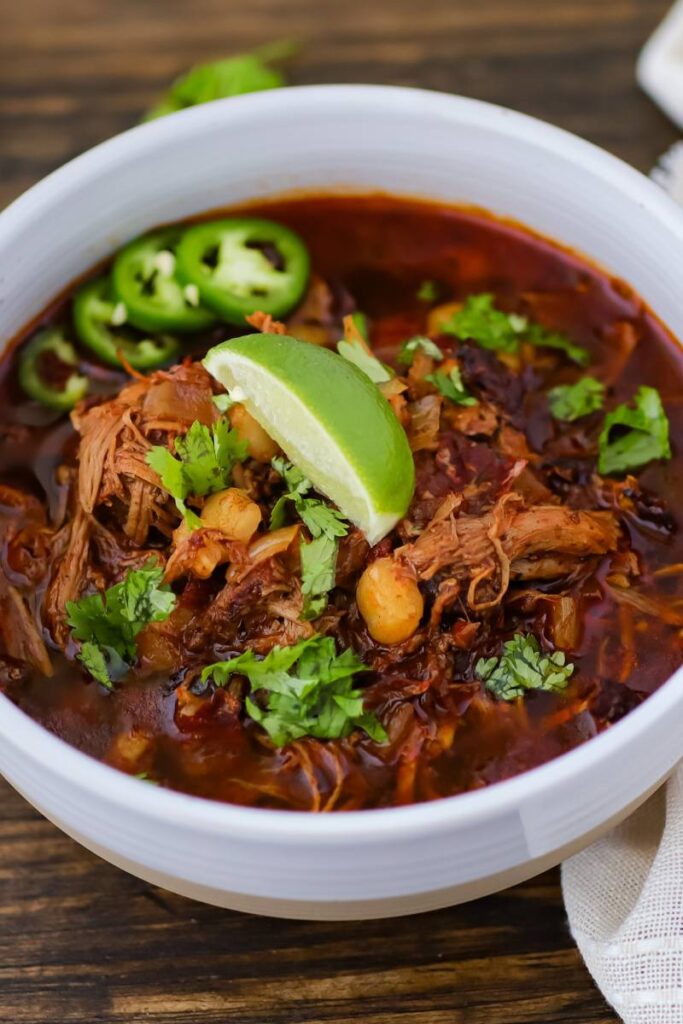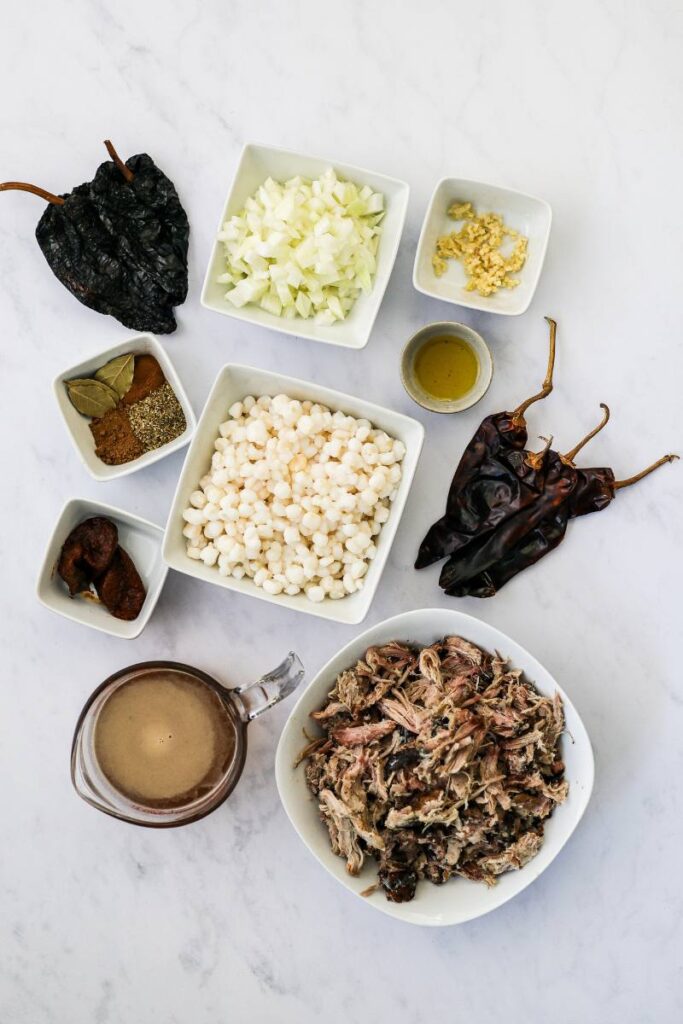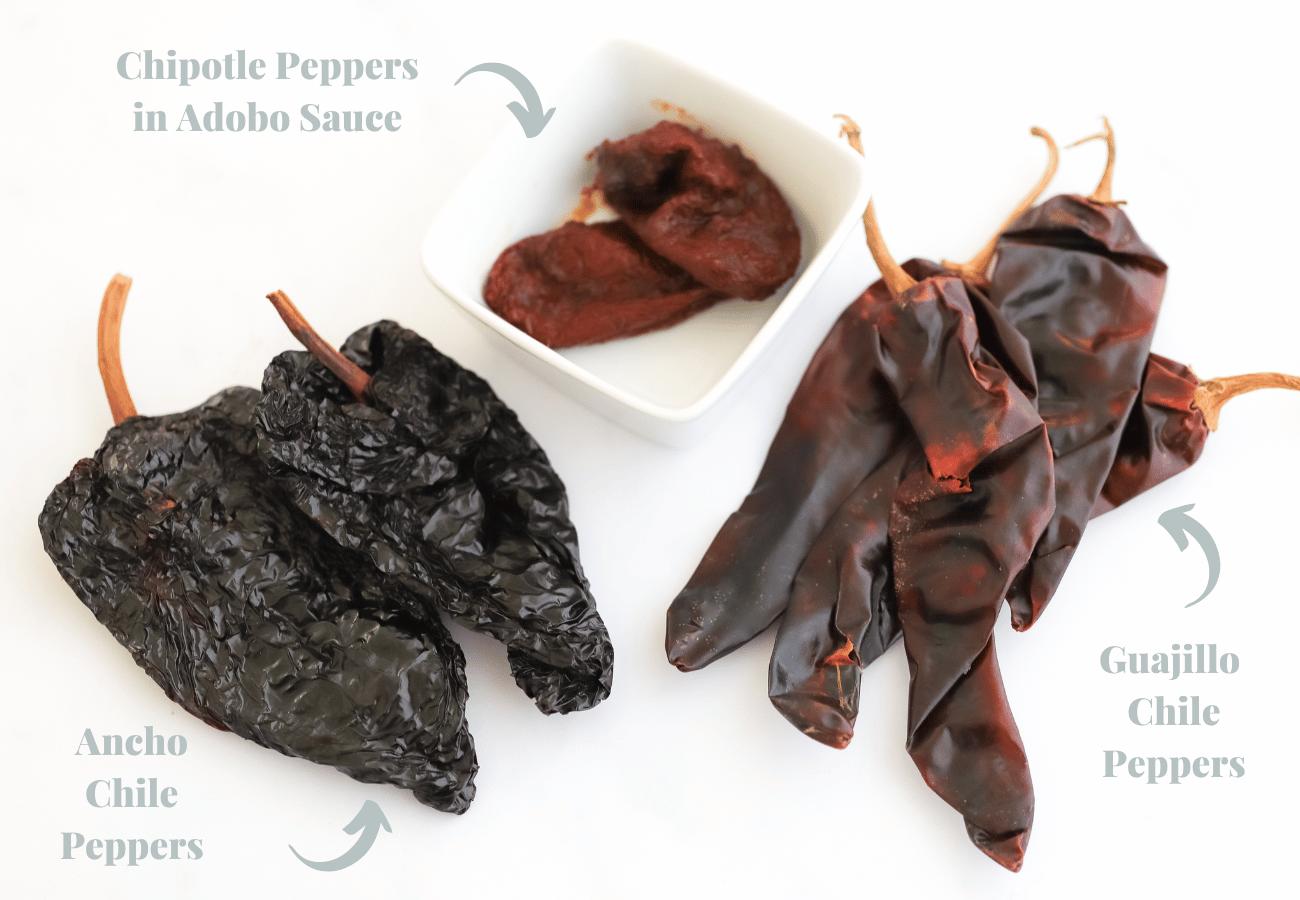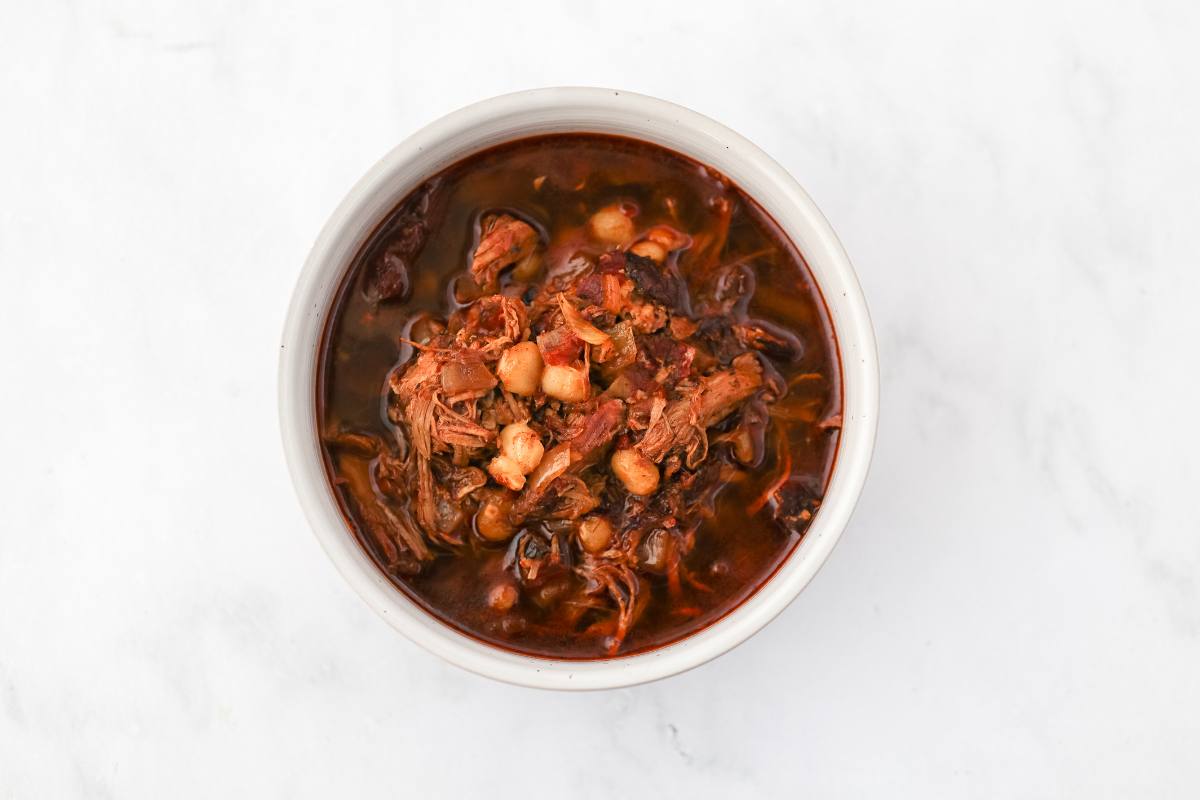Nothing says warm winter comfort like a big bowl of stew, and this pork pozole rojo receta – red pork posole recipe – has it all!
Pozole is a traditional Mexican comfort food that is hearty, flavorful and versatile. If you’re familiar with pozole (also spelled posole) you know there are endless ways to make it your own – from the meat to the types of chiles and the array of toppings. If this is your first foray into exploring how to make pozole, I hope this article will show you how easy it can be to create a pork pozole recipe that tastes and feels like a big bowl of comfort on a cold winter’s night.
Growing up in Texas meant an early introduction to the bold flavors of authentic Mexican cuisine and her much cheesier (and cornier) sister, Tex-Mex. Not all that long ago Texas was a part of Mexico so it makes sense that our state’s cuisine is heavily influenced by our southern neighbor. On more than one occasion this Georgia-based Texan has been called out for high standards while dining at “Tex-Mex” locales outside of state lines. I view it more as a relentless search for a taste of home that often results in sub-par salsa, soggy nachos, tamales piled high with toppings (y’all need to cut that out) and sour cream enchiladas nowhere to be found on the menu.
But this pork pozole rojo? It hits all the high points – travel not required!

What is pozole?
Pozole, or posole, is a Mexican pork and hominy stew that’s often served at celebrations and on holidays, such as Christmas. Its variations are as distinct as Mexico’s regional cuisines. A few things authentic pozole recipes all have in common: savory broth that’s been slow-simmered for hours with garlic, onion, chile peppers and warm spices like Mexican oregano and cumin. From there, the three most well-known variations emerge – red, green and white pozole.
- Red – Pozole rojo (red posole) is among the most recognizable pozole recipes and inspired the recipe I’m sharing with you today. The red color comes from the red chiles used in the broth. My favorite is traditional pork pozole rojo, but I’ve had some amazing pozole rojo recipes made with chicken.
- Green – Pozole verde (green posole) gets its color from green chiles and tomatillos. New Mexico’s green chile chicken stew is a variation of pozole verde.
- White – Pozole blanco features a clear broth and omits the chiles that give pozole rojo and pozole verde their color. Pozole blanco largely relies on slow-simmered pork, herbs and spices for its flavor, which is considered milder that its green and red counterparts.
A note on spice levels: Chiles are an important ingredient in global cuisines and Mexico’s dishes are no exception. You may be wondering if pozole is spicy. The types of chile peppers used in my pozole recipe are mild: full of flavor, low on spice. The spiciest chile peppers are the chipotles and you can reduce the amount you use if you’re particularly sensitive to spice.

Pozole Ingredients
Ready to make an amazing pork pozole? Here’s what you’ll need for my favorite recipe – and it’s one you’ll want to put on repeat all winter. Make a big batch and freeze it for those days when you’re looking for a quick and cozy bowl of ready-to-reheat comfort.
- Pork – My husband loves to smoke meat and keeps our freezer stocked with smoked pulled pork, chicken and brisket. Smoking pork in a smoker typically takes between 12-18 hours, but you can use store-bought or leftover pulled pork or shredded pork for this recipe as long as it has not been cooked in barbecue sauce. Authentic pozole recipes typically simmer for several hours (and are totally worth the wait!) but we’re cutting our cooking time in half by using prepared pork that boasts a deep, smoky flavor.
- White Hominy – These little kernels originate from maize, or field corn. This recipe calls for two 14.5-ounce cans of white hominy. Yellow hominy also works well.
- Chiles – Dried ancho and guajillo chiles pair well with chipotle chiles in adobo sauce, adding extra flavor and giving this smoked pork pozole rojo its rich red color. You’ll find dried ancho chiles and dried guajillo chilis in the international food aisle of your grocery store, online or at a local Mexican or Latin American grocery store. Dried chiles do require a few minutes of special attention before they’re ready for the posole so be sure to follow the step-by-step directions below.
- Aromatics: white onion, garlic cloves and spices – Dice and mince the onion and garlic, respectively. For spices, you’ll use ground cumin, dried oregano, bay leaves and cinnamon (yes, cinnamon!) to enhance the beautiful flavor of this pozole rojo recipe.
- Broth or water – I use pork broth or low-sodium chicken broth. Feel free to use your broth of choice or water.
- Toppings – Fresh oregano, diced radish, avocado, cilantro, lime wedges, crumbled cotija cheese, tortilla chips … top your pozole to your liking. Think of this pork pozole as a canvas for your own delicious creation.

How to Make Pozole Rojo
Step 1. Prepare the chile peppers.
Don’t be thrown off by how long this section is. I want to be thorough for first-timers. If you’re not used to working with chiles, feel free to wear kitchen gloves.
First, we’ll get a small pot (a saucepan is sufficient) of water boiling on the stove. As the water comes to a boil, remove the stems from the dried ancho and guajillo peppers and slice each pepper vertically down the middle. Remove and discard the seeds. When the water is boiling, add the peppers, cover, turn off the heat and set a timer for 10 minutes.
Meanwhile, prepare the chipotles. Transfer 2-3 chipotle peppers in adobo sauce to a small food processor or blender. Add 1/4 cup of your broth or water and process until smooth, about 30 seconds. Pour the mixture into a bowl and set aside. No need to clean your food processor or blender at this point. You’ll use it again for the dried peppers.
When your timer goes off, transfer the peppers to the food processor or blender along with about ½ cup of the chile water. You may need to do this in small batches based on the size of your processor or blender. Process the peppers until smooth and set them aside in a separate bowl. Do not combine the ancho and guajillo pepper mixture with the chipotle peppers, keep them in two separate bowls.
Step 2. Prepare the aromatics, toppings and remaining ingredients.
Dice the onion, mince the garlic, measure the spices, drain and rinse the hominy. Prepare your toppings.
Step 3. Sauté the aromatics.
In a large stew pot or Dutch oven, heat the extra-virgin olive oil over medium heat and add the onions and garlic. Sautee until fragrant, about 3-5 minutes. Add the cumin, oregano, cinnamon and salt to the pot and sauté until fragrant, about 30-45 seconds. Add the chipotle chile mixture and continue to sauté briefly, about 30 seconds.
Step 4. Combine the chile base with remaining ingredients.
Using a metal mesh strainer, pour the ancho and guajillo chile pepper mixture through the strainer and into the pot. Next, pour the broth or water through the strainer. You want to get as much of the chile liquid as possible without adding the chewy little pieces of dried pepper to your soup. If needed, use a spoon to gently push the liquid through the strainer.
Step. 5. Cook the pork pozole rojo.
Increase to medium-high heat and bring the soup base to a boil. Add the pork, hominy and bay leaves and return the stew to a boil. Reduce heat and simmer for about 10 minutes. Remove the bay leaves.
Step 6. Garnish and serve.
This Pozole Rojo recipe makes about six to eight servings. Ladle the stew into bowls, garnish and serve.
Print
Pozole Rojo | Red Posole
How to make pozole rojo in an hour or less? Smoked pulled pork or pre-cooked shredded pork is the key. Add a combination of savory spices, a dash of cinnamon and three types of chile peppers for a pork pozole rojo recipe that is quick simmered to perfection.
- Total Time: 60 mins.
- Yield: 6-8 1x
Ingredients
- 1 ounce dried ancho chile peppers, seeded and stems removed
- 1 ounce dried guajillo peppers, seeded and stems removed
- 2–3 chipotle peppers in adobo sauce
- 1 cup reserved chile water
- 2 teaspoons extra-virgin olive oil
- 1 medium onion, diced
- 4–5 large garlic cloves, minced
- 2 teaspoons dried oregano
- 2 teaspoons ground cumin
- 1 teaspoon cinnamon
- 1 teaspoon salt
- 3 bay leaves
- 4 cups of chicken broth or water
- 1.5 pounds smoked pulled pork or shredded pulled pork* (see note in Ingredients section above)
- 2 14.-5 cans white hominy
- Toppings of choice, for garnish
Instructions
- Bring a small saucepan or pot of water to a boil. Remove stems from the dried ancho and guajillo peppers and slice each pepper vertically down the middle to remove and discard the seeds. the dried peppers to the pan, cover, turn off the heat and set a timer for 10 minutes.
- Transfer the chipotle peppers in adobo to a small food processor or blender. Add 1/4 cup of broth/water and process until smooth, about 30 seconds. Pour the mixture into a bowl and set aside.
- When your ancho and guajillo peppers have boiled for about 10 minutes, transfer the peppers to the food processor or blender in small batches along with the reserved chile water. Process the peppers until smooth, about 30-45 seconds. Do not combine the ancho and guajillo pepper mixture with the chipotle peppers. Set them aside in a separate bowl.
- Dice the onion, mince the garlic, measure the spices, drain and rinse the hominy. Prepare your toppings.
- In a large stew pot or Dutch oven, heat extra-virgin olive oil over medium heat. Add the onions and garlic. Sauté until fragrant, about 3-5 minutes. Add the cumin, oregano, cinnamon and salt to the pot and continue to sauté for 30-45 seconds. Add the chipotle chile mixture and continue to sauté briefly.
- Pour the ancho and guajillo chile pepper mixture through a metal mesh strainer and into the pot. Next, pour the broth or water through the strainer. You want to get as much as the chile liquid as possible without adding the chewy little pieces of dried pepper to your soup. If needed, use a spoon to gently push the liquid through the strainer.
- Increase heat to medium-high and bring the soup base to a boil. Add the pork, hominy and bay leaves and return the stew to a boil. Reduce heat and simmer for about 10 minutes. Remove bay leaves.
- Ladle the stew into bowls, garnish and serve.
Notes
- This recipe calls for minimal salt because there may already be a good amount of salt in the meat, depending on the type of pork you use. Taste and adjust the salt to your preferences.
- This recipe is freezer friendly.
- Prep Time: 20 mins.
- Cook Time: 40 mins.
- Category: Soups + Stews
- Method: Stovetop
- Cuisine: Mexican


So informative!! Good information here. Definitely going to give this a try.
Thank you! Please try it and let me know what you think. I hope you enjoy it as much as we do!